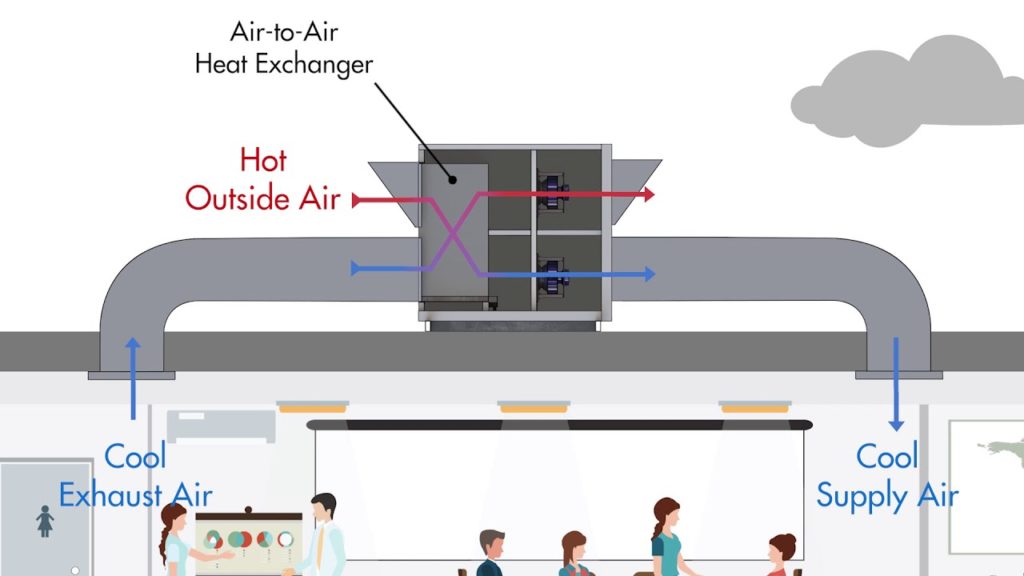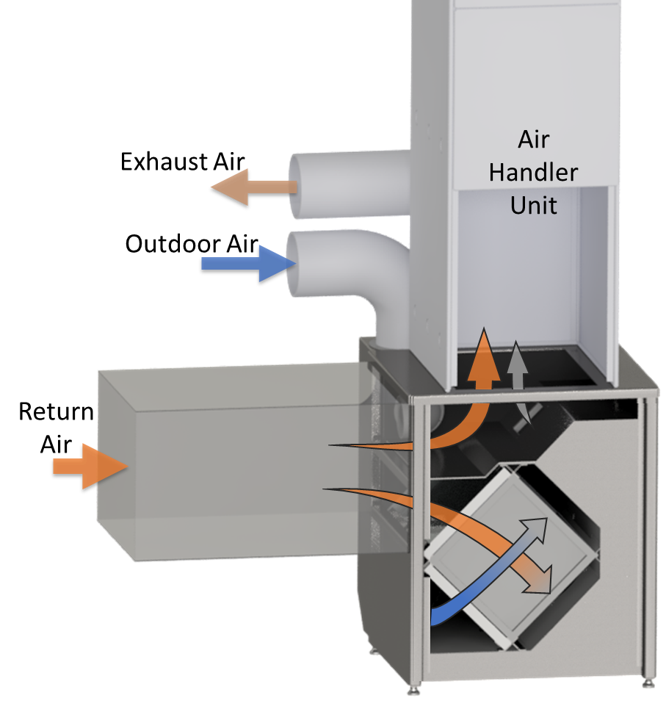“Heat Recovery Ventilator” (HRV) has become a key term in the constantly changing home comfort and energy efficiency landscape. It is critical to comprehend the role of cutting-edge technologies that improve indoor air quality and energy conservation as we navigate the complexities of modern living. The understated HRV is proof of this union, silently carrying out an essential task that has a big impact on our day-to-day existence.
In this investigation, we get to the core of the issue, solving the enigma surrounding HRVs and illuminating their diverse contributions to the development of more sustainable, healthier living spaces. Come along on this journey as we reveal the mysteries surrounding the Heat Recovery Ventilator and how it has revolutionized the way we live in our homes and breathe.
What is a Heat Recovery Ventilator (HRV)?

A Heat Recovery Ventilator (HRV) is a sophisticated and energy-efficient ventilation system designed to enhance indoor air quality while minimizing energy loss in residential and commercial buildings.
Its main purpose is to recover and preserve the energy used to heat or cool the interior space while continuously supplying clean outdoor air and eliminating stale indoor air.
HRVs achieve this by utilizing a heat exchanger—a core component that allows the transfer of heat between the outgoing and incoming air streams.
In cold climates during the winter, the heat exchanger transfers heat from the outgoing, stale air to the incoming fresh air.
Conversely, in warmer climates or during the summer, the process is reversed, expelling excess heat from the incoming air to the outgoing air, helping to cool the indoor environment.
What Benefits Do Heat Recovery Ventilators Offer?

In both residential and commercial settings, Heat Recovery Ventilators (HRVs) provide a number of advantages that enhance indoor air quality, energy efficiency, and general comfort.
Here are some key advantages:
- Enhanced Indoor Air Quality: HRVs ensure a continuous supply of fresh outdoor air, reducing the concentration of indoor pollutants such as dust, allergens, and volatile organic compounds (VOCs). This helps create a healthier living or working environment by minimizing the risk of respiratory issues and other health concerns related to poor indoor air quality.
- Energy Efficiency: By recovering and transferring heat between the incoming and outgoing air streams, HRVs help conserve the energy used for heating or cooling indoor spaces. This energy recovery process is especially valuable in climates with extreme temperature variations, as it reduces the overall demand on heating and cooling systems.
- Cost Savings: The energy efficiency offered by HRVs translates into cost savings on heating and cooling bills. By optimizing the use of existing energy resources, these systems contribute to a more sustainable and budget-friendly approach to maintaining indoor comfort.
- Condensation Control: HRVs play a role in managing humidity levels within a building. Through the process of heat and moisture exchange, they aid in preventing condensation problems, which may otherwise result in the growth of mold and structural damage.
- Comfort and Temperature Control: The consistent supply of fresh air and the regulation of indoor humidity contribute to a more comfortable and pleasant indoor environment. HRVs help maintain a stable and desirable temperature while ensuring proper ventilation.
- Environmental Sustainability: The energy-efficient operation of HRVs aligns with environmental sustainability goals by reducing overall energy consumption and lowering greenhouse gas emissions associated with heating and cooling systems.
- Compliance with Building Codes: Many building codes and standards now include requirements for mechanical ventilation to ensure adequate indoor air quality. HRVs provide an effective solution to meet these regulations, making them a valuable addition to both new and existing buildings.
- Noise Reduction: HRVs are designed to operate quietly, contributing to a peaceful indoor environment. The low noise levels ensure that the ventilation process does not disturb the occupants.
How Do HRV Systems Work?

Systems known as Heat Recovery Ventilators (HRVs) effectively replace stale indoor air with outside air while also reclaiming heat (or coolness) from the outgoing air to prepare the incoming air. The heat exchanger is the main part that is in charge of this exchange. Here’s a detailed breakdown of how HRV systems function:
- Air Intake: Fresh outdoor air is drawn into the HRV system through an intake vent. This air typically comes from the surroundings outside the building.
- Stale Air Exhaust: Simultaneously, stale indoor air is expelled from the building through an exhaust vent. This air is usually extracted from areas like kitchens, bathrooms, and other spaces with higher concentrations of pollutants.
- Heat Exchanger: The heart of the HRV system is the heat exchanger. This component allows for the exchange of heat (or coolness) between the outgoing and incoming air streams without them physically mixing. In cold weather, the heat exchanger captures the warmth from the outgoing indoor air and transfers it to the incoming fresh outdoor air. In warm weather, the process is reversed, expelling excess heat from the incoming air to the outgoing air.
- Air Distribution: The now-conditioned fresh air is distributed to various rooms in the building through a network of ducts. The distribution system ensures an even supply of fresh air to all living or working spaces.
- Energy Recovery:The heat exchanger in HRV systems contributes to energy recovery. By transferring heat between the outgoing and incoming air streams, the system helps to conserve the energy used for heating or cooling the indoor space. This energy efficiency is especially valuable in climates with extreme temperature variations.
- Controls and Ventilation Rate: HRV systems often come equipped with controls that allow users to adjust the ventilation rate based on their specific needs. This function guarantees that the system will maintain maximum comfort and energy efficiency while adjusting to shifting indoor and outdoor conditions.
- Condensate Management: In addition to heat exchange, some HRV systems also include features to manage moisture levels. This helps prevent condensation issues that could lead to mold growth and structural damage.
- Air Filtration (Optional): Some HRV systems may include air filtration components to further improve indoor air quality by capturing particles such as dust, pollen, and allergens.
By performing this continuous exchange and recovery process, HRV systems contribute to maintaining a healthy indoor environment by ensuring a constant supply of fresh air while conserving the energy invested in conditioning that air. This makes HRV systems a valuable addition to buildings seeking a balance between indoor air quality, energy efficiency, and overall comfort.
What is the Average Effectiveness of HRV?

The effectiveness of a Heat Recovery Ventilator (HRV) is typically measured by its efficiency in recovering and transferring heat between the outgoing and incoming air streams. This efficiency is expressed as a percentage and is commonly referred to as the “sensible heat recovery efficiency.”
On average, HRV systems have a sensible heat recovery efficiency ranging from 60% to 90%. This means they can recover and transfer significant heat from the indoor air to the incoming outdoor air. The efficiency can vary based on several factors, including the HRV system’s design, the heat exchanger’s quality, and the operating conditions.
It’s important to note that while HRVs effectively recover sensible heat, they may not recover latent heat (related to moisture content). Some HRV systems, however, may have features designed to manage moisture and improve latent heat recovery.
Additionally, the overall effectiveness of an HRV system depends on how well it is installed, maintained, and integrated into the building’s ventilation strategy. Proper sizing and installation are crucial to ensuring optimal performance.
When considering the effectiveness of an HRV, it’s also essential to consider the specific climate and environmental conditions of the location where the system is installed. HRVs are particularly beneficial in climates with extreme temperature variations, as they help reduce the energy required for heating or cooling.
To determine the most suitable HRV for a particular application, consulting with HVAC professionals and considering factors such as local climate, building size, and ventilation requirements is advisable. Regular maintenance and cleaning of the HRV system are also essential to ensure continued efficiency.
